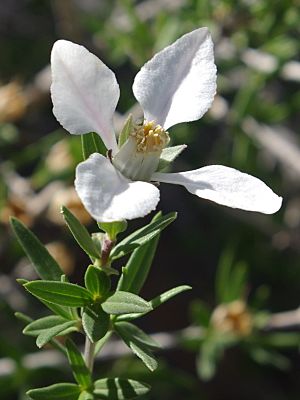Cliff fendlerbush facts for kids
Quick facts for kids Cliff fendlerbush |
|
|---|---|
 |
|
| Fendlera rupicola | |
| Scientific classification | |
| Genus: |
Fendlera
|
| Species: |
rupicola
|
The Fendlera rupicola, also known as the cliff fendlerbush or false mockorange, is a type of shrub. It grows in dry, rocky places in the mountains of North America, especially in the southern central parts.
What Does it Look Like?
The fendlerbush is a deciduous shrub, which means it loses its leaves every year. It can grow to be about one to three meters (3 to 10 feet) tall. Its branches are strong and tough, with gray, grooved bark.
The leaves grow in pairs on opposite sides of the stem. They are long and narrow, thick, and often a bit twisted. Each leaf has three clear veins.
The flowers are a pretty creamy-white color. They bloom at the end of short branches, either alone or in small groups of up to three. Each flower has four purplish parts called sepals and four narrow petals. In the center, you'll see a small cluster with four styles and eight stamens.
After the flowers, the plant produces fruits that are like small capsules. These capsules often stay on the plant for a long time.
Where Does it Grow?
You can find the fendlerbush in mountain areas across several states in the United States, including Texas, New Mexico, Colorado, Utah, and Arizona. It also grows in the northern parts of Mexico.
It's quite common in the Trans-Pecos region of Texas. You can also spot it in specific mountain ranges like the Davis Mountains, the Chisos Mountains, and the Guadalupe Mountains.
Where Does it Live?
This shrub usually grows in places that are quite dry, like semi-arid areas. It's often found in plant communities where blue grama grass (Bouteloua gracilis) is common. These areas are often filled with pinyon pine and juniper trees.
The fendlerbush likes to grow on dry, rocky slopes, in deserts, and on flat-topped hills called mesas. It often shares its home with other plants like oneseed juniper (Juniperus monosperma), alligator juniper (J. deppeana), true pinyon (Pinus edulis), gray oak (Quercus grisea), skunkbush sumac (Rhus trilobata), mountain mahogany (Cercocarpus breviflorus), and antelope bitterbrush (Purshia tridentata).
Traditional Uses
Native American tribes have used the fendlerbush for many purposes over a long time.
- The Navajo used parts of this plant for traditional health practices, for example, to help with stomach discomfort.
- They also used it to help with common issues like head lice.
- The plant was important in many traditional Navajo ceremonies and rituals.
- Its strong wood was used by Havasupai and Navajo people to make tools like arrow shafts.
- The Hopi people also used the plant in their religious ceremonies.
- Navajo people used the wood to create special sticks for their mountain chant ceremony.
- They also crafted useful items like weaving forks, planting sticks, and knitting needles from the wood.
- In some Navajo ceremonies, the plant was boiled with other ingredients like juniper berries and corn meal for special meals.
See also
 In Spanish: Fendlera rupicola para niños
In Spanish: Fendlera rupicola para niños

